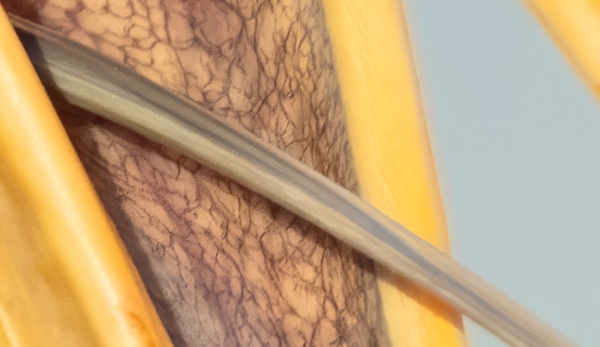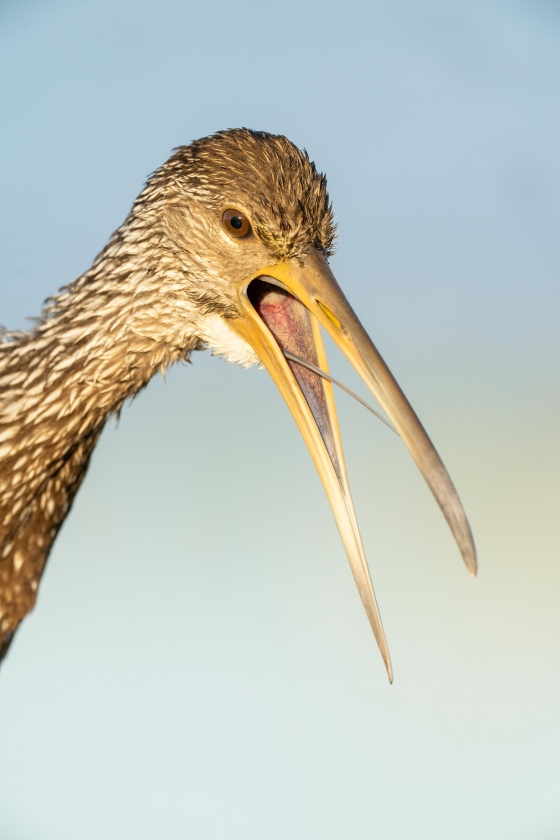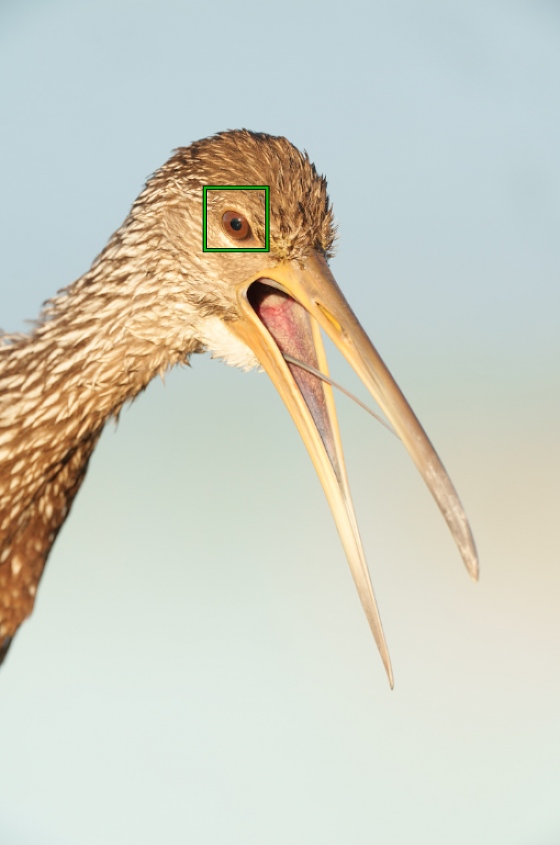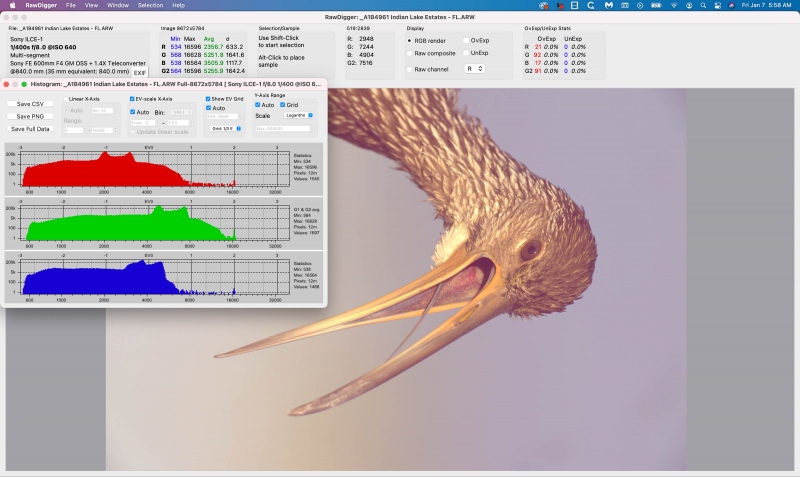|
|
Image #1: A 500% unsharpened crop of the master file |
Before You Scroll Down …
Before you scroll down to view today’s featured image, see if you can figure out what you are looking at in the 500% crop above. And enjoy the amazing detail of a sharp Alpha 1 image file magnified to a borderline insane level.
Unfair to Birds?
With the amazing AF system of the Sony Alpha 1 (with Bird-Eye/Face Detection!), its stunning image files, the ease of getting the right exposure, and with RawDigger to teach you to further refine your exposures, bird photography today seems almost unfair to the birds. I, for one, am enjoying my photography more than ever. Today’s featured image illustrates these points perfectly.
What’s Up?
The weather on Saturday morning is looking dead-solid perfect for a Your Pick In-the-Field session at Lakeland. The details are below. And time is short as I am outta here next coming Friday.
On Thursday morning,I got down to the pier 10 minutes before sunrise. It should have been 20 … While I was setting up my gear at the car, I watched a Great Blue Heron fly right at the pier flapping hard all the way. And that bird was followed by a Sandhill Crane that did the exact same thing. Oh well. With a nice pink-purple sky to the west, I created more than 700 mostly Cattle Egrets leaving the roost blurs and kept 23. Working off the tripod with the Levered-Clamp FlexShooter Pro and the big lens with the 1.4X TC, my framing was (as expected) much better than it had been the day before when hand holding the 200-600 with the same TC. Note: with lighter, shorter focal length lenses, hand holding will usually yield better results than working on a tripod.
I drove around a bit without seeing much and then returned to the pier. There were a few Turkey Vultures on the railings along with one unusual bird. As you will see below, I did well. Sunset was looking good from the pool deck just before 5:00pm, but when I got down to the lake I saw a large dark cloud on the western horizon that would soon envelop the sun. It did. But I was enjoying the peace and quiet so I stayed and tried some extreme blurs, utilizing shutter speeds as low as 1/8 sec. I had fun and created a few almost … I should have mentioned either yesterday or above, that when I am creating hundreds of blurs while working in Shutter Priority mode, that I am changing shutter speeds often. When I pick my keepers, I do not look at the shutter speeds. It is when reviewing the keepers that the shutter speed is noted. It’s just another way to learn.
Today is Friday 7 January. I leave for San Diego in one week. Yesterday I changed my flight and extended my stay by five days. What can I say? I love the place and I love the pelicans. I get back home on the afternoon of Thursday 27 January. The forecast for this morning is for cloudy and very still early. I will be down to the pier early working on more pleasing blurs. Wherever you are, and whatever you are doing, I hope that you too have a great day. This blog post took more than 90 minutes to prepare and makes 58 consecutive days with a new one.
Please remember that you can find some great photo accessories (and necessities, like surf booties!) on Amazon by clicking on the Stuff tab on the orange/yellow menu bar above. On a related note, it would be extremely helpful if blog-folks who, like me, spend too much money on Amazon, would get in the habit of clicking on the Amazon logo link on the right side of each blog post when they shop online. As you might expect, doing so will not cost you a single penny, but would be appreciated tremendously by yours truly. And doing so works seamlessly with your Amazon Prime account.
Please remember that if an item — a Delkin flash card, or a tripod head — for example, that is available from B&H and/or Bedfords, is also available in the BAA Online Store, it would be great, and greatly appreciated, if you would opt to purchase from us. We will match any price. Please remember also to use my B&H affiliate links or to save 3% at Bedfords by using the BIRDSASART discount code at checkout for your major gear purchases. Doing either often earns you free guides and/or discounts. And always earns my great appreciation.
Your-Pick In-the-Field Sessions
The beauty of the Your Pick In-the-Field Sessions plans below is that I am free most days from now until I leave for San Diego on 14 January. The best news is that we can schedule sessions to coincide with the perfect weather forecast. These sessions are ideal for central Florida locals or folks visiting the region for whatever reason. Interested? Get in touch via e-mail or better yet, try my cell at 863-221-2372. Please leave a message and shoot me a text if I do not pick up. Inquire for couples and group rates.
Indian Lake Estates In-the-Field Sessions
Two hours of intensive instruction: $300.00. Add a working brunch with image review: $100.00. Sunset shoot: $100.00. Guest room lodging available. Mix and match.
Sunny mornings with east winds are best. Likely subjects include ridiculously tame Sandhill Cranes along with Black and Turkey Vultures, Crested Caracara, Limpkin, Great Egret, Great Blue Heron, and more. Bald Eagle possible; crane chicks coming soon.
Lakeland or Circle B Bar Preserve
Two hours of intensive instruction: $325.00. Add a working brunch with image review: $100.00. Mix and match.
Sunny mornings with winds that have an easterly component are best at Lakeland. Likely subjects include point-blank American White Pelican, Anhinga, Limpkin, Common Moorhen, White Ibis, a variety of wintering ducks including Ring-necked and Wood Duck, and lots more.
Cloudy mornings or afternoons (shooting session only) are best at Circle B Bar Preserve. Likely subjects include Great Blue Heron, Great Egret, Little Blue Heron, Snowy Egret, Tricolored Heron, White Ibis, Common Moorhen, Osprey, Red-shouldered Hawk, American Alligator, Wild Boar, and more. If you wish to mix and match, lodging at ILE is available.
Sony Alpha 1 Bodies in Stock at Bedfords/free card offer!
Steve Elkins of Bedfords let me know late yesterday that he had several Sony a1 bodies in stock. If one of them has your name on it, please click here and be sure to enter the BIRDSASART coupon code check the box for free shipping to enjoy free Second Day Air Fed-Ex. Right now, in lieu of the 3% credit refunded to the card you used for your purchase, you will receive a Sony 160GB CFexpress Type A TOUGH Memory Card, a $399.99 value!
Brand New and As-Good-As-Ever Bedfords BAA Discount Policy
Folks who have fallen in love with Bedfords can now use the BIRDSASART coupon code at checkout to enjoy a post-purchase, 3% off-statement credit (excluding taxes and shipping charges) on orders paid with a credit card. The 3% credit will be refunded to the card you used for your purchase. Be sure, also, to check the box for free shipping to enjoy free Second Day Air Fed-Ex. This offer does not apply to purchases of Classes, Gift Cards, or to any prior purchases.
Money Saving Reminder
Many have learned that if you need a hot photo item that is out of stock at B&H and would like to enjoy getting 3% back on your credit card along with free 2nd Day Air Fed-Ex Air shipping, your best bet is to click here, place an order with Bedfords, and enter the coupon code BIRDSASART at checkout. If an item is out of stock, contact Steve Elkins via e-mail or on his cell phone at (479) 381-2592 (Central time). Be sure to mention the BIRDSASART coupon code and check the box for Free Shipping. That will automatically upgrade to free 2nd Day Air Fed-Ex. Steve has been great at getting folks the hot items that are out of stock at B&H and everywhere else. The waitlists at the big stores can be a year or longer for the hard to get items. Steve will surely get you your gear long before that. For the past year, he has been helping BAA Blog folks get their hands on items like the SONY a 1, the SONY 200-600 G OSS lens, the Canon EOS R5, the Canon RF 100-500mm lens, and the Nikon 500mm PF. Steve is personable, helpful, and eager to please.
Important Note
As an Amazon Associate, I earn a small percentage when you purchase from Amazon after using any of the Amazon links on the blog (including the logo-link immediately above). My link works with Amazon Prime and using it will not cost you a single cent. Huge thanks, BTW 🙂
Please Remember Also
Please, if you enjoy and learn from the blog, remember to use one of my two affiliate programs when purchasing new gear. Doing so just might make it possible for me to avoid having to try to get a job as a Walmart greeter and will not cost you a single penny more. And if you use Bedfords and remember to enter the BIRDSASART code at checkout, you will (still!) save 3% on every order and enjoy free second-day air shipping. In these crazy times — I lost about fifty thousand dollars in income due to COVID 19 — remembering to use my B&H link or to shop at Bedfords will help me out a ton and be greatly appreciated. Overseas folks who cannot order from the US because of import fees, duties, and taxes, are invited to help out by clicking here to leave a blog thank you gift if they see fit.


Gear Questions and Advice
Too many folks attending BAA IPTs and dozens of photographers whom I see in the field and on BPN, are–out of ignorance–using the wrong gear, especially when it comes to tripods and more especially, tripod heads… Please know that I am always glad to answer your gear questions via e-mail. If you are desperate, you can try me on my cell at 863-221-2372. Please leave a message and shoot me a text if I do not pick up.
|
|
|
This image was created on 6 January 2021 on the pier at the lake near my home at Indian Lake Estates, FL. Standing at full height, I used the no-longer-available Induro GIT 304L/Levered-Clamp FlexShooter Pro-mounted Sony FE 600mm f/4 GM OSS lens with the Sony FE 1.4x Teleconverter, and The One, the Sony Alpha 1 Mirrorless Digital Camera.. ISO 640. The exposure was determined by Zebras with ISO on the rear wheel: 1/400 sec. at f/8 (stopped down 1 stop) in Manual mode. AWB at 8:13:04am on a sunny morning. Tracking: Spot S AF-C with Bird-Eye/Face Detection performed perfectly. Click on the image to enjoy the high-res version. Image #1A: Limpkin calling |
Serendipitously Vertical!
There has been a Limpkin sitting on the railing near the foot of the pier for several weeks now. It is quite tame allowing folks to get within 15 feet before leaning forward and dropping down into the marsh grasses. I had been looking for a good opportunity to photograph it. When I headed out to try for some vulture on the railing head shots, I was glad to see the Limpkin in his favorite spot. With the bird lens on the tripod I needed to approach carefully while keeping the tripod very close to the boardwalk. I moved forward only inches at a time. I was creating both horizontals and verticals and by chance, I was working vertically when the bird began calling. I figured that 1/400 second would be sharp enough to freeze the calling bird. Calling Limpkins are quite loud, and sound like someone being murdered. When this bird flew to the north, another tame Limpkin landed on the pier railing so I kept on shooting.
Had I been working in horizontal format when the bird called it would have been very difficult to avoid clipping the bill. Lucky ducky me.
|
|
Image #B: Sony Imaging Edge Desktop screen capture showing the active AF point |
Tracking: Spot S AF-C with Bird-Eye/Face Detection
At times, using Tracking: Spot S AF-C with Bird-Eye/Face Detection seems almost like cheating. When I think back to the days when we had to focus manually by turning the focusing ring (or one of the two large wheels on the Canon FD 800mm f/5.6 lens), I am 100% totally flat-out amazed. Oh, and the FD 800mm lens focused all the way down to 45 feet! In any case, the Sony AF technology, as you can see above, is simply beyond amazing.
SONY Alpha a1 Set-up and Info Group
The SONY Alpha a1 Set-up and Info Group is going great guns as more and more folks chime in with thoughtful questions and experience-based answers. As the a1 is becoming more readily available, more and more folks are getting their hands on this amazing body. This week, two folks in the group ordered their third a1! I am envious. The group is now up to an astounding 102 lucky and blessed folks. Early on, we discussed the myriad AF options. I gave my opinion as to the best one for flight and general bird photography. The best news is that all who wish, can request an e-mail that includes a .DAT file with my a1 settings on it, and explicit directions on how to load my settings onto your a1; talk about convenience! (Note: I am now offering updated .DAT files).
All who purchased their Alpha a1 bodies via a BAA affiliate link will receive a free subscription to the Sony Alpha a1 Set-Up and Info Updates group after shooting me their receipts via e-mail. (Note: it may take me several days to confirm B&H orders.) This same service may be purchased by anyone with an a1 body via a $150.00 PayPal sent to birdsasart@verizon.net indicating payment for Alpha a1 Info & Updates. Alternatively, folks can call Jim weekdays at 1-863-692-0906 to pay via credit card. New members will receive composite e-mails that summarize all previous discussions.
|
|
Image #1C: The RawDigger screen capture for the Limpkin calling image |
Dead-Solid Perfect!
Images where the G channel gets 2/3rds of the way from the 8000 to the 16000 line are perfect exposures. Images where the G channel gets right up to the line are dead-solid perfect. With 221 OvExp pixels out of 51,000,000, this is a (yet another) dead-solid perfect exposure. All of the OvExp pixels are in the tiny specular highlights near the base of the bill.
RawDigger — not for the faint of heart …
Nothing has ever helped me learn to create perfect exposures to the degree that RawDigger has. I think that many folks are reluctant to learn that most of their images are underexposed by one or more full stops and that highlight warnings in Photoshop, Lightroom, Capture One, and your in-camera histogram are completely bogus as they are based on the embedded JPEGs. Only your raw files tell the truth all the time. Heck, I resisted RawDigger for several years … Once you get over that feeling, RawDigger can become your very best exposure friend no matter what system you are using. On the recent IPTs and In-the-Field sessions, we have demonstrated that fact. Convincingly.
The RawDigger (pink) Adapted Histogram
In the RawDigger e-Guide, you will learn exactly how to set up the Adapted “pink” RawDigger Histogram and how to use it to quickly and easily evaluate the exposure or raw file brightness of images from all digital cameras currently in use. RawDigger was especially helpful to me when I struggled with R5 exposures and when I learned my new camera body, the Sony Alpha a1.
|
|
RawDigger e-Guide with Two Videos |
The RawDigger e-Guide with Two Videos
by Arthur Morris with Patrick Sparkman
The RawDigger e-Guide was created only for serious photographers who wish to get the absolute most out of their raw files.
Patrick and I began work on the guide in July 2020. At first we struggled. We asked questions. We learned about Max-G values. We could not figure out why the Max G values varied by camera system. IPT veteran Bart Deamer asked lots of questions that we could not answer. We got help from RawDigger creator Iliah Borg. We learned. In December, Patrick came up with an Adapted Histogram that allows us to evaluate the exposures and raw file brightness for all images created with all digital camera bodies from the last two decades. What we learned each time prompted three complete beginning-to-end re-writes.
The point of the guide is to teach you to truly expose to the mega-Expose-to-the-Right so that you will minimize noise, maximize image quality, best utilize your camera’s dynamic range, and attain the highest possible level of shadow detail in your RAW files in every situation. In addition, your properly exposed RAW files will contain more tonal information and feature the smoothest possible transitions between tones. And your optimized images will feature rich, accurate color.
We teach you why the GREEN channel is almost always the first to over-expose. We save you money by advising you as to which version of RawDigger you need. We teach you how to interpret the Max G values for your Canon, Nikon, and SONY camera bodies. It is very likely that the Shock-your-World section will shock you. And lastly — thanks to the technical and practical brilliance of Patrick Sparkman — we teach you a simple way to quickly and easily evaluate your exposures and raw file brightness using an Adapted RawDigger histogram.
The flower video takes you through a session where artie edits a folder of images in Capture One while checking the exposures and Max-G values in RawDigger. The Adapted Histogram video examines a series of recent images with the pink histograms and covers lots of fine points including and especially how to deal with specular highlights. The directions for setting up the Adapted Histogram are in the text.
If we priced this guide based on how much effort we put into it, it would sell it for $999.00. But as this guide will be purchased only by a limited number of serious photographers, we have priced it at $51.00. You can order yours here in the BAA Online Store.
Typos
With all blog posts, feel free to e-mail or to leave a comment regarding any typos or errors.




















Is the Limpkin eating something or is something stuck in its mouth?? Great focus and great colors in these photos!!
The bird was calling (screaming).
with love, artie